Anatomy and physiology coloring workbooks, like the 12th edition by Elaine N. Marieb, offer an interactive way to study complex biological systems. These workbooks combine detailed illustrations with coloring exercises, helping students engage visually and reinforce their understanding of anatomical structures. Available in both physical and digital formats, including PDF, they provide flexibility for learners. The exercises cover various body systems, from skeletal to nervous, making them a valuable tool for students and professionals alike. This approach fosters active learning, enhancing retention and comprehension of key concepts.
1.1 Importance of Visual Learning in Anatomy and Physiology
Visual learning is crucial in anatomy and physiology, as it helps students grasp complex structures and relationships. Coloring workbooks, like Elaine N. Marieb’s 12th edition, provide interactive exercises that enhance memory retention and spatial awareness. By engaging with detailed illustrations, learners can better understand anatomical systems, making abstract concepts more tangible. This method reduces study stress and improves comprehension, proving invaluable for both students and professionals.
1.2 Overview of the Anatomy and Physiology Coloring Workbook
The Anatomy and Physiology Coloring Workbook is a comprehensive study guide designed for 1- and 2-semester courses. It features detailed illustrations of anatomical structures, covering various body systems. Available in formats like PDF, it provides engaging exercises to reinforce learning. Ideal for students and professionals, this workbook can be used independently or alongside primary textbooks, offering a hands-on approach to mastering complex biological concepts effectively.

Benefits of Using a Coloring Workbook for Anatomy and Physiology
- Enhances visual learning
- Boosts memory retention
- Improves spatial awareness
- Reduces study stress
- Engaging and interactive learning tool
2.1 Enhancing Memory Retention Through Coloring
Coloring engages both visual and kinesthetic learning, enhancing memory retention of complex anatomical structures. By actively coloring, students better differentiate between tissues, organs, and systems, reinforcing their understanding. This interactive process strengthens neural pathways, making anatomical details easier to recall during exams and clinical applications. The Anatomy and Physiology Coloring Workbook leverages this method to improve long-term knowledge retention effectively.
2.2 Improving Spatial Awareness and Understanding of Anatomical Structures
Coloring helps learners visualize the 3D arrangement of anatomical structures, enhancing spatial awareness. By coloring layers of tissues, organs, and systems, students better understand their relationships and locations. This hands-on approach clarifies complex structures, such as muscles and their attachments, making abstract concepts more tangible. The workbook’s detailed illustrations guide users to accurately color and comprehend spatial anatomy, improving their ability to mentally reconstruct the human body.
2.3 Reducing Study Stress Through Interactive Learning
Interactive coloring exercises provide a calming, creative outlet, reducing study-related stress. The tactile activity of coloring engages the brain, making learning enjoyable and less overwhelming. By focusing on coloring, students can take breaks from intense textbook studying, lowering anxiety and improving focus. This method also enhances memory retention, making complex concepts feel more manageable and fostering a positive learning experience.

Structure and Organization of the Workbook
The workbook is organized into chapters, each focusing on specific anatomical systems, with corresponding coloring exercises and theoretical explanations; This systematic approach ensures comprehensive coverage of key concepts, making learning structured and accessible for students.
3.1 Chapter-by-Chapter Breakdown of Key Topics
The workbook is divided into chapters, each focusing on specific anatomical systems, such as the skeletal, muscular, and nervous systems. Each chapter begins with a brief overview, followed by detailed coloring exercises and theoretical explanations. This structured approach ensures students progressively build their knowledge, starting from basic concepts to complex physiological processes. The organization aligns with standard anatomy and physiology curricula, making it easy to integrate into study routines.
3.2 Integration of Coloring Exercises with Theoretical Content
The workbook seamlessly combines coloring exercises with detailed theoretical explanations, enhancing the learning experience. Each anatomical illustration is accompanied by concise descriptions, allowing students to visualize and reinforce concepts. This integration helps link visual learning with textbook knowledge, making complex structures easier to understand and remember. The combination of hands-on activity with academic content fosters a deeper comprehension of anatomy and physiology.
Key Features of the Anatomy and Physiology Coloring Workbook
The workbook features detailed anatomical illustrations, cross-sectional views, and comprehensive coverage of body systems. It’s available in PDF and physical formats, with the 12th edition offering enhanced content.
4.1 High-Quality Anatomical Illustrations
The workbook includes high-quality anatomical illustrations, designed to provide clear visual representations of complex structures. These detailed diagrams are hand-drawn and precise, making it easier for students to identify and color different anatomical features. The illustrations cover various body systems, from the skeletal to the nervous system, ensuring comprehensive understanding. This visual accuracy aids in effective learning and retention of anatomical details.
4.2 Cross-Sectional Views and Detailed Diagrams
The workbook features cross-sectional views and detailed diagrams that provide a deeper understanding of internal anatomical structures. These visuals highlight the spatial relationships between bones, muscles, and organs, aiding in the identification of complex systems. The intricate illustrations allow students to color and explore various body parts in detail, enhancing their ability to comprehend and retain anatomical information effectively.
4.3 Comprehensive Coverage of Body Systems
The workbook offers an extensive review of all major body systems, including skeletal, muscular, nervous, cardiovascular, and digestive systems. Each section is designed to provide a thorough understanding of how these systems function and interact. The detailed coverage ensures that students can explore and color each system’s components, reinforcing their knowledge and preparing them for comprehensive exams and real-world applications in healthcare.
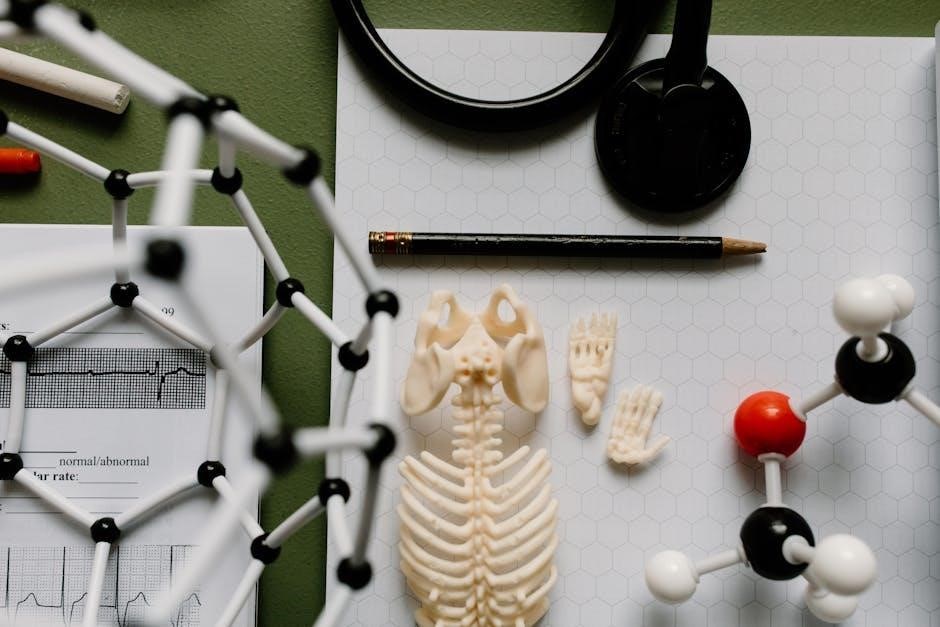
Popular Anatomical Systems Covered in the Workbook
The workbook covers key anatomical systems, including skeletal, muscular, nervous, cardiovascular, and digestive, providing detailed illustrations for interactive learning. These systems are essential for healthcare education.
5.1 Skeletal System: Bones and Joints
The skeletal system section focuses on bones and joints, with detailed illustrations of the human skeleton. Each bone is labeled, and joints are shown in various states of motion. Coloring exercises help students identify different bone structures, such as the long bones of the limbs and the vertebrae of the spine. This interactive approach enhances understanding of skeletal anatomy and how bones articulate to form joints, which are crucial for movement. The workbook also includes cross-sectional views of bones, revealing their internal structures like the spongy bone and marrow cavity. By coloring these diagrams, learners can better visualize and remember the complex shapes and functions of the skeletal system, making it easier to grasp how bones contribute to overall body structure and mobility. Additionally, the exercises cover the classification of joints, such as synovial, cartilaginous, and fibrous joints, highlighting their roles in facilitating different types of movement. This hands-on method ensures that students not only memorize the names of bones and joints but also understand their spatial relationships and functional importance in the human body.
5.2 Muscular System: Major Muscle Groups and Their Functions
The muscular system section details major muscle groups, including skeletal, smooth, and cardiac muscles. Coloring exercises focus on identifying muscle origins, insertions, and actions, enhancing understanding of their roles in movement. Detailed diagrams highlight muscle layers and fascia, while cross-sectional views reveal muscle fibers and their structural components. This interactive approach helps learners visualize how muscles interact with bones and joints, facilitating comprehension of human locomotion and physiology. By engaging with these visuals, students can better grasp the functional anatomy of muscles, improving their ability to relate structure to movement. The workbook also emphasizes the classification of muscles based on their locations and functions, such as flexors, extensors, and rotators, providing a comprehensive overview of the muscular system. This hands-on learning method enhances retention and spatial awareness, making complex anatomical concepts more accessible and memorable for students.
5.3 Nervous System: Brain, Spinal Cord, and Peripheral Nerves
The nervous system section focuses on the brain, spinal cord, and peripheral nerves, highlighting their roles in controlling body functions. Coloring exercises illustrate neural pathways, synapses, and the structure of neurons. Detailed diagrams depict the brain’s lobes and their functions, while cross-sectional views of the spinal cord reveal nerve tracts. This interactive approach helps learners visualize how the central and peripheral nervous systems integrate to regulate movement, sensation, and cognition. By engaging with these visuals, students gain a deeper understanding of the nervous system’s complex anatomy and its vital role in maintaining homeostasis. The workbook’s clear illustrations and coloring activities simplify the study of this intricate system, making it more accessible for learners at all levels.
The Role of Coloring in Understanding Physiological Processes
Coloring enhances understanding of physiological processes by visually engaging learners, improving memory retention, and providing an interactive way to explore complex anatomical and functional concepts effectively.
6.1 Blood Circulation and the Cardiovascular System
Coloring workbooks help visualize blood circulation pathways, enhancing understanding of how oxygen and nutrients are delivered to tissues. Detailed illustrations of the heart’s chambers, blood vessels, and capillaries allow learners to trace and color blood flow, aiding in memorization of physiological processes. This interactive approach simplifies complex concepts like oxygen delivery and carbon dioxide removal, making the cardiovascular system more accessible for study and review.
6.2 Digestive Processes and Nutrient Absorption
Coloring workbooks provide detailed illustrations of the digestive system, enabling learners to visualize how food is broken down and nutrients are absorbed. By coloring the digestive tract, organs like the stomach and intestines, and processes such as enzyme secretion, students gain a clearer understanding of mechanical and chemical digestion. Interactive exercises highlight nutrient absorption in the small intestine, making complex physiological processes more engaging and easier to comprehend.
6.3 Respiratory Mechanisms and Gas Exchange
Respiratory mechanisms and gas exchange are vividly illustrated in coloring workbooks, allowing learners to explore the lungs’ structure and function. Detailed diagrams of alveoli and capillaries enable visualization of oxygen and carbon dioxide exchange. Coloring exercises simplify complex processes like inhalation, exhalation, and diffusion, making respiratory physiology more accessible and memorable for students studying anatomy and physiology.
Digital vs. Physical Versions of the Workbook
Digital versions offer convenience and interactive features, while physical workbooks provide a tactile experience and better visual clarity for detailed anatomical study and accessibility.
7.1 Pros and Cons of Digital Anatomy Coloring Books
Digital anatomy coloring books, such as the anatomy and physiology coloring workbook PDF, offer portability and accessibility on multiple devices. They provide easy updates and space-saving benefits. However, they require specific apps for editing, may cause eye strain, and lack the tactile experience of physical books, making them less accessible for those without suitable technology.
7;2 Advantages of Traditional Physical Coloring Workbooks
Physical anatomy and physiology coloring workbooks provide a tactile experience, enhancing engagement and focus. They eliminate the need for digital devices, reducing eye strain and distractions. The hands-on activity fosters better retention and spatial understanding. Additionally, physical workbooks allow for easier annotation and a sense of accomplishment as students see their progress. They remain accessible without technology, making them a reliable study tool for all learners.
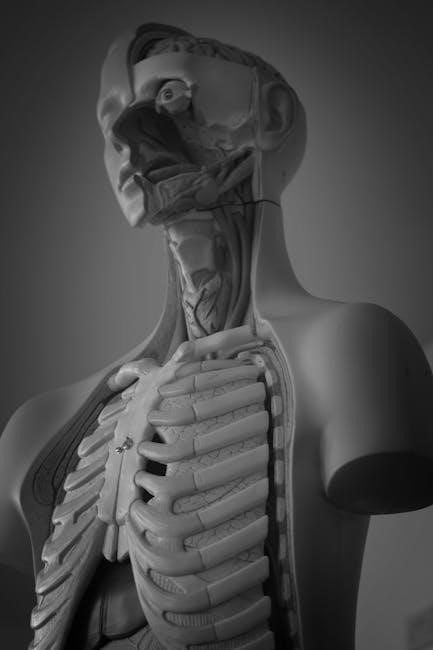
Tips for Effective Use of the Coloring Workbook
Use the workbook alongside lectures and textbooks for reinforced learning. Color anatomical structures carefully, referring to diagrams, and review completed pages regularly to enhance retention and understanding.
8.1 Best Practices for Coloring Anatomy
Start by understanding the color-coding system in the workbook. Use consistent colors for similar structures to enhance recognition. Always reference the provided diagrams for accuracy. Focus on one anatomical structure at a time to avoid confusion. After coloring, review the structures using lecture notes or textbooks. Highlight key terms and concepts for better retention and quick revision. This method ensures effective learning and makes the workbook a valuable study resource.
8.2 Using the Workbook in Conjunction with Lecture Notes
Integrate the workbook with lecture notes by coloring anatomical structures while reviewing class materials. Cross-reference diagrams with textbook illustrations for consistency. Highlight key terms in notes to align with colored sections. This dual approach enhances visual learning and reinforces complex concepts. Regularly review colored exercises alongside lecture summaries to deepen understanding and ensure comprehensive preparation for exams or practical applications.
User Reviews and Feedback on the Anatomy and Physiology Coloring Workbook
Students and educators praise the workbook for its engaging, interactive approach. Many highlight its effectiveness in simplifying complex concepts and aiding exam preparation. The PDF format is particularly commended for its convenience and accessibility, making it a valuable resource for anatomy and physiology studies.
9.1 Student Testimonials and Success Stories
Students have shared overwhelmingly positive experiences with the anatomy and physiology coloring workbook PDF, praising its ability to make complex topics engaging and memorable. Many reported improved exam performance and a deeper understanding of anatomical structures due to the interactive nature of the exercises. The workbook’s visual and hands-on approach has been particularly commended for its effectiveness in reinforcing key concepts and promoting active learning;
9.2 Feedback from Educators and Professionals
Educators and professionals highly recommend the anatomy and physiology coloring workbook PDF, citing its effectiveness in reinforcing anatomical knowledge. Many highlight its ability to complement traditional textbooks and enhance interactive learning. Professionals appreciate its detailed illustrations and comprehensive coverage of body systems, while educators value its role in bridging the gap between theoretical concepts and practical application, making it a valuable resource for health science education.

Future Editions and Updates to the Workbook
Future editions of the anatomy and physiology coloring workbook PDF are expected to include enhanced digital features, improved illustrations, and expanded coverage of emerging topics in the field.
10.1 Upcoming Features in the Next Edition
The next edition of the anatomy and physiology coloring workbook PDF will feature enhanced digital capabilities, including interactive 3D models and augmented reality integration. New coloring exercises will focus on emerging topics in physiology, such as cellular signaling and immunology. Additionally, the workbook will include more detailed cross-sectional views and a comprehensive review section for self-assessment. These updates aim to further enrich the learning experience.
10.2 How User Feedback Shapes Workbook Development
User feedback plays a crucial role in refining and enhancing the anatomy and physiology coloring workbook PDF. Suggestions from students and professionals guide updates, ensuring the content remains relevant and effective. Feedback has led to improvements such as additional detailed diagrams, better digital tools, and expanded coverage of complex systems. This collaborative approach ensures the workbook evolves to meet the needs of its users.
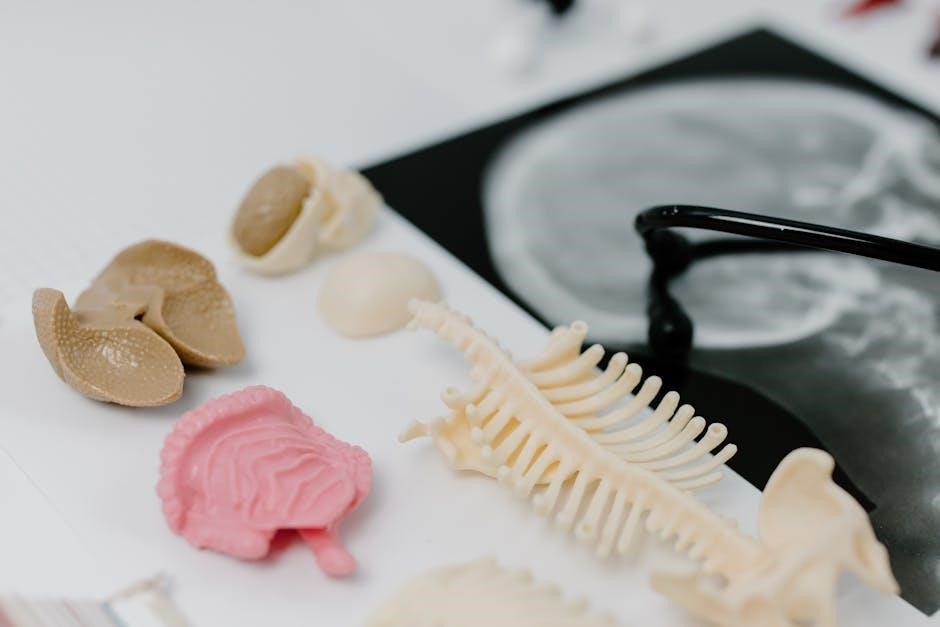
Supplementary Resources for Anatomy and Physiology Study
Supplementary resources, such as recommended textbooks and online courses, complement the workbook. Interactive tools and apps enhance anatomy learning, offering additional engagement and understanding opportunities.
11.1 Recommended Textbooks and Online Courses
Recommended textbooks like Anatomy and Physiology Coloring Workbook by Elaine N. Marieb and Clinical Anatomy by Regions provide in-depth knowledge. Online courses, such as those offering interactive anatomy lessons, complement the workbook. PDF resources and digital files, like Anatomy.Physiology.20th.Ed.pdf, are also available for convenient study. These tools enhance learning by offering a blend of theoretical and practical content, supporting the workbook’s exercises effectively.
11.2 Interactive Tools and Apps for Anatomy Learning
Interactive tools like 3D anatomy apps and virtual dissection software enhance learning. Apps such as Complete Anatomy and Anatomy 4D offer detailed visualizations. Online platforms provide quizzes, flashcards, and simulations. These tools complement the workbook by allowing students to explore anatomical structures dynamically, aiding in better retention and understanding of complex physiological processes. They are particularly useful for visual learners and those seeking hands-on engagement with the material.
The anatomy and physiology coloring workbook is a valuable resource that enhances learning through interactive engagement. By combining visual and tactile exercises, it aids in retention and understanding, making complex concepts more accessible for students. This tool is indispensable for those seeking to master human anatomy and physiology effectively.
12.1 Summary of Key Benefits and Features
The anatomy and physiology coloring workbook is an interactive learning tool that enhances retention and understanding through visual engagement. It features detailed anatomical illustrations, covering body systems from skeletal to nervous. The workbook is available in both physical and digital formats, including PDF, offering flexibility for students. Its structured exercises make complex concepts accessible, making it an invaluable resource for anatomy and physiology studies.
12.2 Final Thoughts on the Importance of Visual Learning
Visual learning is essential for grasping anatomy and physiology, as it engages multiple senses and enhances memory retention. The coloring workbook’s detailed illustrations and interactive exercises provide a hands-on approach to understanding complex structures. By linking colors to concepts, learners create mental associations that simplify comprehension. This method is particularly effective for visual learners, making it a powerful tool for mastering human anatomy and physiology effectively.

Frequently Asked Questions (FAQs)
Is the workbook suitable for beginner students? Yes, it provides clear illustrations and explanations. Can it be used without a primary textbook? Absolutely, it’s a standalone resource for visual learning.
13.1 Is the Workbook Suitable for Beginner Students?
The workbook is ideal for beginners, offering a comprehensive introduction to anatomy and physiology through engaging visuals and clear explanations. It simplifies complex concepts, making it accessible for those new to the subject. The interactive nature of coloring helps students build a strong foundation, allowing them to grasp essential terminology and structures effectively from the start.
13.2 Can the Workbook Be Used Without a Primary Textbook?
The Anatomy and Physiology Coloring Workbook can be used independently, as it provides a comprehensive overview of key concepts and structures. While it complements primary textbooks, it is designed to stand alone, offering detailed illustrations, theoretical content, and exercises. This makes it a versatile tool for students who prefer self-directed or visual learning without requiring additional materials.
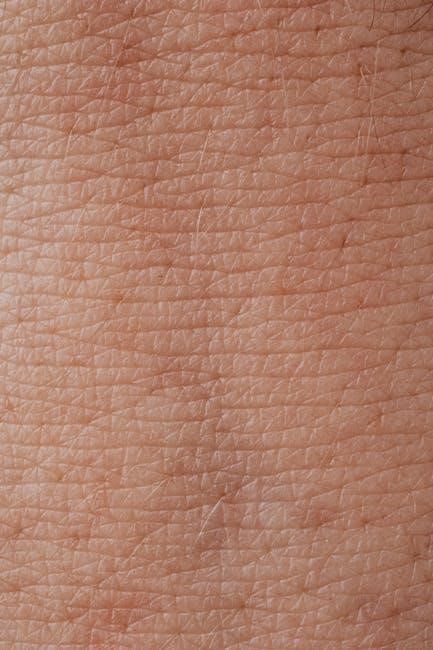
References and Further Reading
Key resources include Elaine N. Marieb’s Anatomy and Physiology Coloring Workbook and Dover’s Anatomy Coloring Book. These texts provide comprehensive coverage and detailed visuals, serving as valuable resources for students and professionals alike.
14.1 Academic Sources for Anatomy and Physiology
Elaine N. Marieb’s Anatomy and Physiology Coloring Workbook is a leading resource, offering detailed illustrations for interactive learning. Dover’s Anatomy Coloring Book provides classic, high-quality images. Veterinary anatomy resources, such as Saunders Veterinary Anatomy Coloring Book, cater to specialized studies. These texts, along with clinical anatomy guides, are essential for comprehensive understanding and memorization of anatomical structures and physiological processes.
14.2 Additional Coloring Resources for Medical Students
Beyond the Anatomy and Physiology Coloring Workbook, resources like Saunders Veterinary Anatomy Coloring Book and Dover’s Anatomy Coloring Book provide specialized studies. Digital options, such as downloadable PDF anatomy physiology workbooks, offer convenience. These tools cater to diverse learning needs, enhancing retention through interactive and visual engagement, making them invaluable for medical and healthcare students seeking comprehensive anatomical understanding.
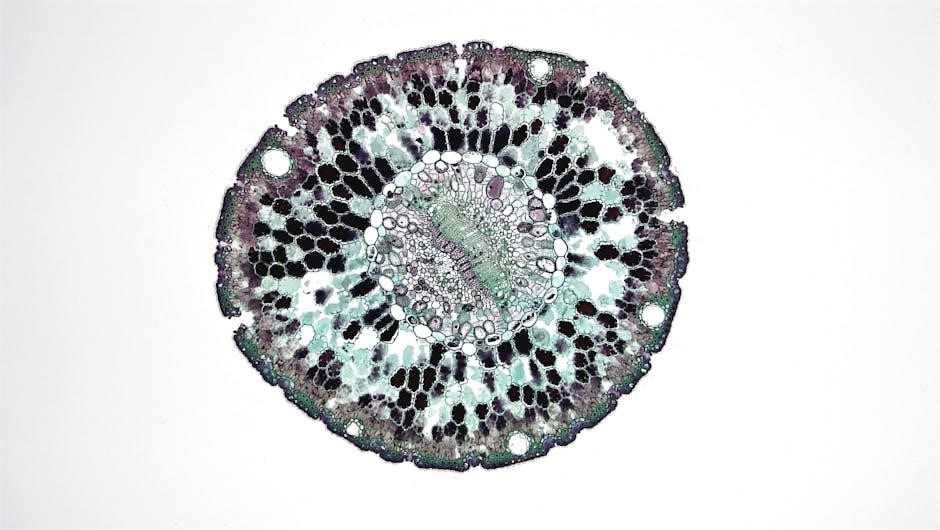
Final Thoughts
The Anatomy and Physiology Coloring Workbook PDF revolutionizes learning by combining visual engagement with comprehensive content. Its interactive approach simplifies complex concepts, making it an invaluable tool for students and educators alike. This workbook not only enhances understanding but also fosters a deeper appreciation for the intricate beauty of human anatomy and physiology.
15.1 The Evolution of Anatomy Education
The evolution of anatomy education has shifted from passive textbook learning to interactive tools like the Anatomy and Physiology Coloring Workbook PDF. This transition emphasizes visual and hands-on engagement, enhancing retention and comprehension. Digital formats, such as PDF, have made these resources more accessible, catering to diverse learning preferences and fostering a deeper understanding of complex anatomical structures and physiological processes.
15.2 The Role of Interactive Tools in Modern Learning
Interactive tools, such as the Anatomy and Physiology Coloring Workbook PDF, revolutionize learning by engaging students through visual and tactile exercises. These tools enhance retention, cater to diverse learning styles, and provide practical applications of complex concepts. Digital formats like PDF ensure accessibility, allowing learners to study anytime, anywhere, while fostering a deeper connection to the material and improving overall educational outcomes for students and educators alike.
